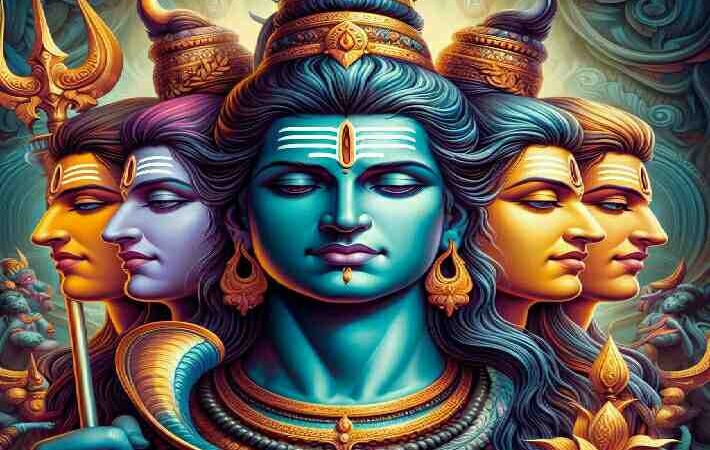Bhagavati:Embodiment of Divine Femininity

Bhagavati or Devi holds a prominent place in Hinduism, especially within the Shakta tradition, where she symbolizes the divine feminine energy known as Shakti. Shakti is considered the active force without which the male aspect, Purusha, remains dormant. Worship of Shakti is fundamental in Hindu practices, highlighting the importance of recognizing and honoring the divine feminine.

Devi, also known by various names such as Adi Parashakti, Ma Ambey, Mahashakti, or Devi Ma, embodies the limitless cosmic power beyond the universe. She is both the creator and destroyer, representing the dynamic force that sustains all existence. In Hindu mythology, Devi is revered as the Supreme Being, Para Brahman, from whom all other goddesses originate. Among her manifestations, Bhagavati is often depicted with eight hands and is considered a form of the powerful goddess Durga. Devotees celebrate her presence and seek her blessings during festivals like Dussehra and Durga Puja, acknowledging her role as the source of prosperity and protection.
Devi Bhagavati Mantra
ॐ नमो भगवती रक्तं पीठं नम: ll
Om namo bhagavati raktam peetham namah ll
Synonyms and Meaning of the Mantra
“Om” – A sacred sound and a spiritual symbol in Hinduism.
“Namo” – I bow to or I honor.
“Bhagavati” – Referring to the divine feminine, often associated with the goddess Devi or Shakti.
“Raktam Peetham” – Red and yellow, representing the colors associated with Devi.
“Namah” – I bow to or I offer salutations.
So, the meaning of the mantra could be interpreted as “I bow to the divine feminine, adorned in red and yellow.” It’s a reverential invocation of the goddess Bhagavati.
Forms of Adi Parashakti
Parvati or Durga
Parvati, also known as Durga, is the original manifestation of Adi Parashakti herself. As Parvati, she epitomizes the qualities of love, compassion, and devotion. She is the divine consort of Lord Shiva and embodies the ideal of marital harmony and familial bliss. Parvati is revered as the nurturing mother who bestows blessings upon her devotees and protects them from harm. Her serene demeanor belies her immense strength, which she unleashes as Durga, the fierce warrior goddess. Durga is depicted riding a lion or tiger, wielding various weapons, and battling demons to restore cosmic order. Devotees invoke her during times of adversity, seeking her protection and courage to overcome obstacles. Parvati and Durga represent the dual aspects of femininity – the gentle and nurturing mother, and the fierce and protective warrior – reminding devotees of the balance between strength and compassion in their own lives.
Mahasaraswati
Mahasaraswati is not only the embodiment of wisdom and creativity but also serves as the patroness of learning and the arts. She symbolizes purity and clarity of thought, guiding seekers on the path of knowledge and enlightenment. As the shakti of Lord Brahma, the creator of the universe, Mahasaraswati facilitates the process of creation by inspiring innovation and intellect. Artists, scholars, and students invoke her blessings to excel in their respective fields, seeking her guidance to unlock their potential and express themselves fully.
Mahalakshmi
Mahalakshmi’s influence extends beyond material wealth to encompass spiritual abundance and fulfillment. She is not merely the goddess of prosperity but also represents inner riches, such as peace, contentment, and spiritual growth. Devotees worship her to attract not only financial prosperity but also blessings for overall well-being and happiness. Mahalakshmi’s radiant presence illuminates the lives of her devotees, instilling a sense of gratitude and generosity. Through her grace, individuals experience the joy of abundance in all aspects of their lives, fostering a deeper connection to the divine and a greater appreciation for life’s blessings.
Mahakali
Mahakali embodies the fierce and transformative aspect of Adi Parashakti, symbolizing the power of destruction and regeneration. She is revered as the divine mother who destroys ignorance, ego, and negativity, clearing the path for spiritual awakening and liberation. Mahakali’s dark complexion represents the infinite potentiality of the universe, from which new beginnings emerge. Devotees seek her blessings to overcome obstacles, conquer fears, and embrace change fearlessly. Through her fierce grace, Mahakali guides souls towards ultimate liberation, leading them from darkness to light, from bondage to freedom.
Bhagavati Temples
Bhagavati temples are revered places of worship dedicated to the deity Bhagavati, who holds significant importance in regions like Kerala, Goa, Konkan, and other parts of India.
In Kerala, several notable Bhagavati temples stand out, including the Attukal Bhagavati Temple, Chottanikkara Bhagavathy Temple, Chettikulangara Devi Temple, Kodungallur Bhagavati Temple, Kadampuzha Devi Temple, Pisharikavu, Kavaserry Bhagavati Temple, and Mangottu Bhagavati Temple. Additionally, the Mondaicaud Bhagavati Temple near Kolachal in the western coast of Kanyakumari district, Tamil Nadu, also attracts devotees.
Goa boasts numerous Bhagavati temples, where the deity is predominantly worshipped in the form of Mahishasur Mardini by communities such as Goud Saraswat Brahmins, Daivadnya Brahmins, and Bhandaris. Bhagavati is often venerated as one of the Panchayatana deities in Goan temples. Noteworthy shrines dedicated specifically to Bhagavati include Bhagavati in Pernem, Bhagavati Haldonknarin in Khandola, Bhagavati Chimulakarin in Marcela, and Bhagavati in Parse.
Beyond Kerala and Goa, Bhagavati temples can also be found in Maharashtra, exemplified by Bhagavati Devi Sansthan Deosari in Taluk Umarkhed, District Yavatmal, as well as Bhagavati temples in Ratnagiri and Reotipur, Uttar Pradesh.
These temples serve as focal points for devotees to offer their prayers, seek blessings, and participate in various rituals and festivities associated with the worship of Bhagavati, thereby fostering spiritual harmony and cultural richness across the regions where they are situated.





